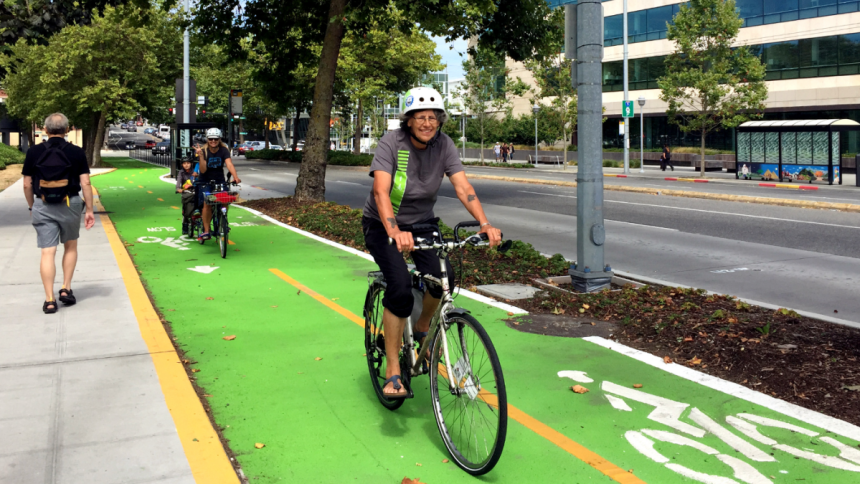As Seattle continues to grow and evolve, promoting safe and accessible urban cycling has become increasingly important. By implementing key strategies and best practices, the city can create a more bike-friendly environment that encourages residents to embrace cycling as a sustainable and healthy mode of transportation.
However, accidents can still occur despite the best efforts to improve cycling safety. In the event of a bicycle accident, cyclists must have access to experienced legal representation. A bike accident lawyer serving Seattle can provide invaluable guidance and support, helping cyclists navigate the legal process and pursue the compensation they deserve.
Expanding and Improving Bicycle Infrastructure
One of Seattle’s most effective strategies for enhancing urban cycling is investing in expanding and improving bicycle infrastructure. This includes creating a comprehensive network of dedicated bike lanes, separated from motor vehicle traffic and connecting key city destinations. By providing cyclists with safe and convenient routes, the city can encourage more people to choose cycling as a primary mode of transportation.
In addition to bike lanes, other infrastructure improvements can include installing bicycle-specific traffic signals, enhancing road markings and signage, and creating secure bicycle parking facilities at transit hubs, workplaces, and popular destinations. By prioritizing bicycle infrastructure, Seattle can demonstrate its commitment to creating a more bike-friendly city and promoting the safety and well-being of its cycling community.
Implementing Traffic Calming Measures
Traffic calming measures are designed to reduce vehicle speeds and create a safer environment for cyclists and pedestrians. These measures include installing speed bumps, narrowing travel lanes, and creating curb extensions or pedestrian islands. The city can reduce the risk of serious accidents involving cyclists by slowing down motor vehicle traffic, especially in residential areas and near schools, parks, and other community spaces.
Another effective traffic calming strategy is the implementation of “bicycle boulevards” or “neighborhood greenways.” These are streets where bicycle traffic is prioritized over motor vehicle traffic, often through traffic diversion, speed reduction, and other design elements. By creating a network of bicycle boulevards throughout the city, Seattle can provide cyclists with safe and low-stress routes that encourage more people to choose cycling for their daily commutes and recreational activities.
Promoting Cyclist Education and Awareness
Educating cyclists about safe riding practices, traffic laws, and their rights and responsibilities on the road is essential for promoting a culture of safe urban cycling in Seattle. The city can partner with local organizations, schools, and community groups to offer bicycle safety courses, workshops, and resources that help cyclists of all ages and skill levels develop the knowledge and confidence they need to safely navigate the city’s streets.
In addition to educating cyclists, raising awareness among motorists about sharing the road safely with bicycles is equally essential. This can include public outreach campaigns, driver education programs, and the inclusion of bicycle safety information in driver’s license testing and renewal processes. Seattle can create a more harmonious and safe environment for all road users by fostering a greater understanding and respect between cyclists and motorists.
Encouraging Employer Support for Bicycle Commuting
Employer support is critical in fostering a bicycle-friendly environment in urban areas. Here’s how employers and cities can collaborate to encourage and support employees who choose to commute by bicycle:
- Facilities and Amenities: Employers can support cycling by providing secure bicycle parking, changing rooms, and showers. These facilities make it more convenient for employees to cycle to and from work.
- Incentive Programs: Implement incentive programs that reward employees who commute by bicycle. This could include financial incentives, recognition programs, or preferential parking.
- Collaboration with the City: Work with city officials to develop programs that support bicycle commuting. This could include “bike-to-work” challenges, group rides, or educational workshops to provide commuter cyclists with skills and knowledge.
- Community Building: These initiatives help foster a community among employees who cycle, making it an appealing option for more workers. By contributing to a sustainable and healthy workforce, employers not only improve traffic conditions but also enhance the well-being of their employees.
Enhancing Bicycle Sharing and Rental Programs
Bicycle sharing and rental programs can be practical tools for promoting urban cycling and making it more accessible to a broader range of people. By providing a network of affordable and convenient bicycle rental stations throughout the city, Seattle can encourage more residents and visitors to try cycling and experience its benefits firsthand.
To ensure the success and safety of bicycle sharing and rental programs, the city should work with program operators to maintain high standards for bicycle maintenance, safety, and user education. This can include regular inspections and repairs of rental bicycles, clear user guidelines and safety instructions, and the provision of helmets and other safety gear. By making bicycle sharing and rental programs safe, reliable, and user-friendly, Seattle can help more people discover the joys and advantages of urban cycling.
Collaborating with Local Organizations and Advocacy Groups
Collaborating with local organizations and advocacy groups is essential for creating a solid and effective movement for safe urban cycling in Seattle. These groups can provide valuable expertise, resources, and community connections to help the city identify and address the unique challenges and opportunities related to cycling in different neighborhoods and communities.
By partnering with organizations such as Cascade Bicycle Club, Seattle Neighborhood Greenways, and other local advocacy groups, the city can tap into a wealth of knowledge and experience related to bicycle safety, infrastructure design, and community engagement. These collaborations can also help build public support for cycling initiatives and ensure that the city’s efforts are responsive to the needs and concerns of the cycling community.
Last Words
To ensure the ongoing success and effectiveness of Seattle’s urban cycling strategies, it is important to assess and improve cycling safety throughout the city regularly. This can include collecting and analyzing data on bicycle accidents, identifying high-risk areas or intersections, and evaluating the effectiveness of existing infrastructure and programs.
Based on these assessments, the city can make data-driven decisions about where to prioritize investments in bicycle infrastructure, education, and outreach. By continuously monitoring and adapting its approach to urban cycling, Seattle can create a dynamic and responsive system that evolves to meet the changing needs of its cycling community and ensures the highest standards of safety and accessibility for all.
Lynn Martelli is an editor at Readability. She received her MFA in Creative Writing from Antioch University and has worked as an editor for over 10 years. Lynn has edited a wide variety of books, including fiction, non-fiction, memoirs, and more. In her free time, Lynn enjoys reading, writing, and spending time with her family and friends.















